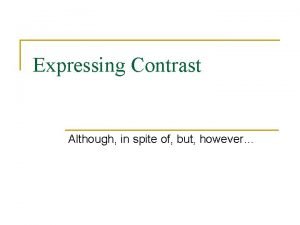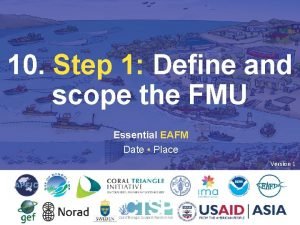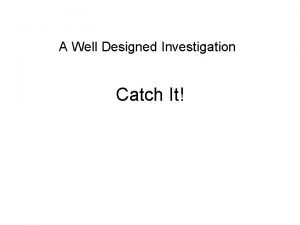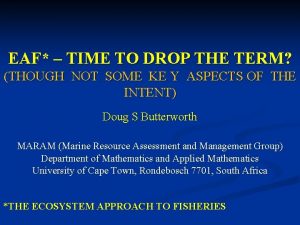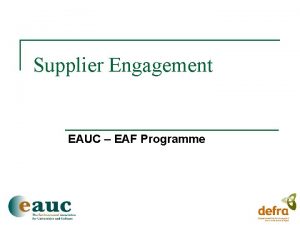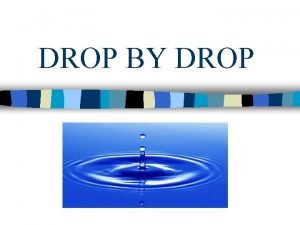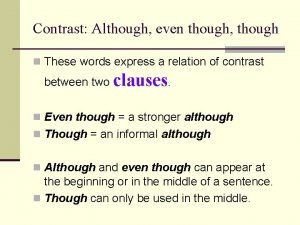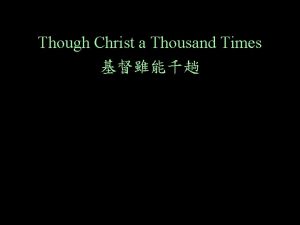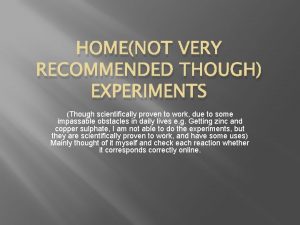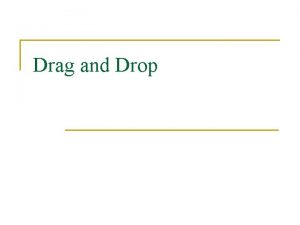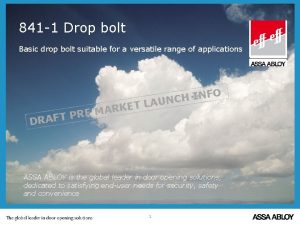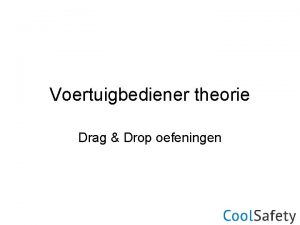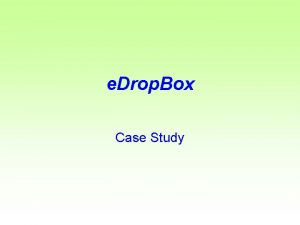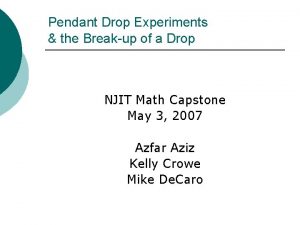EAF TIME TO DROP THE TERM THOUGH NOT









































- Slides: 41

EAF* – TIME TO DROP THE TERM? (THOUGH NOT SOME KE Y ASPECTS OF THE INTENT) Doug S Butterworth MARAM (Marine Resource Assessment and Management Group) Department of Mathematics and Applied Mathematics University of Cape Town, Rondebosch 7701, South Africa *THE ECOSYSTEM APPROACH TO FISHERIES

OUTLINE I. Introductory Comments II. The History III. Definitions and Interpretations IV. The Primary Components V. A South African Perspective i) Where are we now and where should we head? ii) How are such initiatives best structured and advanced? VI. Concluding Remarks

I) INTRODUCTORY COMMENTS EAF IS CONTROVERSIAL WITH WIDE-RANGING VIEWS WORLDWIDE TWO SENIOR EUROPEAN FISHERIES SCIENTISTS “Even for intensively studied Northern Hemisphere fisheries, EAF remains a nebulous aspiration rather than a robust management tool – for that a pre-requisite is inter-species trade-off decisions by managers” “Whoever invented EAF should be shot”

EAF HAS POLITICAL OVERTONES. (Like many other issues in Fisheries Science) ECOLABELLING (including SASSI-like schemes) BECOMING A BIGGER SCIENCE-RELATED CONCERN FOR INDUSTRY THAN EVEN THE SIZE OF THE TAC Why? - No point having a quota if lack of certification means that the fish caught can’t be sold (at a reasonable return) “EAF” RELATED FACTORS ARE PLAYING AN INCREASING ROLE IN CERTIFICATION

II) THE HISTORY (More from a personal involvement than in terms of legislative instruments) CCAMLR (1980) COMMISSION FOR THE CONSERVATION OF ANTARCTIC MARINE LIVING RESOURCES THE FIRST “ECOSYSTEM” FISHERIES CONVENTION CCAMLR ARTICLE II n Take account of the direct AND INDIRECT impact of harvesting n Prevent changes not potentially reversible over two to three decades

CCAMLR ARTICLE II ORIGINS May, Beddington, Clark, Holt and Laws - 1979 Management of multispecies fisheries (Science) Models of a whale-seal-krill ecosystem including predator-prey interactions, and harvesting more than one species NB: “ECOSYSTEM” FOR CCAMLR = FOOD-WEB/MULTISPECIES MODELLING BASIC INTENT OF CCAMLR ECOSYSTEM PROVISIONS Having stopped harvesting on depleted whale populations to allow them to recover, don’t undermine that by taking away

CCAMLR: 1984 SC MEETING SO WHAT DOES ECOSYSTEM MANAGEMENT MEAN AND HOW IS IT TO BE PUT INTO PRACTICE? SA CONTRIBUTION (DSB et al. ) n n Need acceptable multispecies model Not yet possible – need better information on species abundance trends MEETING OUTCOME n n Realistic multispecies models unlikely to be available for some considerable time Minimal information on squid – key research

ECOSYSTEM ISSUES – 1990 s SEAL-FISHERY INTERACTIONS n HARP SEALS INCREASES OFF NEWFOUNDLAND n FUR SEAL INCREASES OFF SOUTHERN AFRICA WHAT IMPACT ON SUSTAINABLE FISH CATCHES – SHOULD SEALS BE CULLED? n NON-RECOVERY OF STELLER SEALIONS IN THE BERING SEA n IMPACT OF KRILL FISHING ON LAND BREEDING PREDATORS (INCLUDING FUR SEALS) IN THE SCOTIA SEA SHOULD FISHERIES BE RESTRICTED? NO SCIENTIFIC CONSENSUS

ECOSYSTEM ISSUES – 1990 s WHALE-FISHERY INTERACTIONS n INCREASING MINKE WHALES OFF NORWAY ON COD n INCREASING WHALE POPULATIONS IN THE NORTWEST PACIFIC ON JAPANESE FISHERIES COINCIDED WITH INCREASINGLY FAVOURABLE VOTES AT CITES TO DOWNLIST ABUNDANT WHALES SPECIES FROM APPENDIX I (“In danger of extinction”) CITES HAD SO LISTED VIRTUALLY ALL WHALE SPECIES IN SUPPORT OF THE 1982 IWC COMMERCIAL WHALING MORATORIUM JAPAN MOUNTED A MAJOR DIPLOMATIC INITIATIVE, PARTICULARLY THROUGH FAO COFI, UNDER THE SOUNDBITE: WE NEED AN “ECOSYSTEM APPROACH TO FISHERIES”

2001: THE REYKJAVIK DECLARATION THE FIRST FORMAL ADOPTION OF “EAF” FOLLOWED CONFERENCE ON “RESPONSIBLE FISHERIES IN THE MARINE ECOSYSTEM” n AIM: TO INCLUDE ECOSYSTEM CONSIDERATIONS IN FISHERIES MANAGEMENT n INCLUDED BUT WENT BEYOND PREDATOR-PREY INTERACTIONS TO INCORPORATE, EG, BY-CATCH AND HABITAT CONSIDERATIONS THE CYNIC’S QUESTION: TO WHAT EXTENT WAS THIS BROADENING A MOVE TO OFFSET THE PRO-WHALING INROADS THE JAPANESE WERE MAKING WITH THEIR (CCAMLR-COMPATIBLE) USE OF THE EAF SLOGAN?

2015: EAF – THE COCHRANE VISION CLEARLY WE NEED TO MOVE TOWARDS MANAGING FISHERIES AS WE DO GAME PARKS, TAKING ACCOUNT OF INTERACTIONS OF SPECIES WITH EACH OTHER AND WITH THE ENVIRONMENT OPERATIONALLY, A CALL FOR THE DEVELOPMENT OF MULTI-SPECIES MODELS AS THE BASIS FOR TACTICAL DECISION MAKING? NOTE: STRATEGIC QUESTION: Will culling seals increase sustainable fishery yields? TACTICAL QUESTION: How many seals need to be culled to increase the sustainable hake catch by 10 000 tons?

WHERE ARE WE 35 YEARS AFTER CCAMLR INITIATED THE ECOSYSTEM APPROACH? CCAMLR n 1984: Realistic multispecies models unlikely to be available for some considerable time Initial Antarctic-wide attempts only by Mori, now being updated by Moosa (SA) Scotia Sea krill fishery impact on predators – only Watters (US) and Plaganyi (SA) Currently initiative through the IWC SC to kick-start renewed attention, plus upcoming Japanese and NZ contributions n 1984: Minimal information on squid – key research priority Still no information on abundance n 1980: Take account of indirect impact of harvesting Mid-90 s: Interim rule pending more refined analyses (de la Mare & DSB) Fishery target for krill: 50%K; Predator preference 100%K; Compromise at 75% 20 years on – no update

WHERE ARE WE 35 YEARS AFTER CCAMLR INITIATED THE ECOSYSTEM APPROACH? SEAL-FISHERY INTERACTIONS n HARP SEALS INCREASES OFF NEWFOUNDLAND Still not fully clear – diet data deficiencies (extent of belly-biting) n FUR SEAL INCREASES OFF SOUTHERN AFRICA Seal increase has stopped, but impact on hake still unclear: Fewer seals gives more shallow water hake whose additional predation reduces deepwater hake – hake TAC could go up or down (1995 – Punt & DSB, now being updated by Ross-Gillespie) n NON-RECOVERY OF STELLER SEALIONS IN THE BERING SEA Research expenditure to ascertain reasons > US $ 100 million Result: We DON’T KNOW n GREY SEALS IN GULF OF ST LAWRENCE Consensus that these are impacting cod recovery Age data shows increased cod M in absence of confounding F (closed fishery) SUCCESS NEEDED AN EXTREME SITUATION

THE MAJOR PROBLEM THE “SECONDARY INTERACTIONS” ARGUMENT (e. g. as in SA seal-hake model) THESE CAN REVERSE THE DIRECTION EXPECTED FROM PRIMARY INTERACTIONS HEAVILY USED BY ENGOs TO COUNTER SEAL CULl. ING PROPOSALS BUT – THIS ALSO APPLIES EQUALLY TO ARGUMENTS THAT REDUCING FISHING WOULD BENEFIT PREDATORS SIMPLER MULTI-SPECIES MODELS WITH BETTER FITS TO DATA ARE APPEALING: MRM – Minimum realistic models MICE – Models of intermediate complexity for ecosystem assessment (Plaganyi) BUT - THEY REMAIN OPEN TO THIS “SECONDARY INTERACTIONS” COUNTER

HOW FREQUENTLY ARE ECOSYSTEM PROCESSES INCLUDED IN TACTICAL FISHERIES MANAGEMENT? Review of RFMOs worldwide plus US and Australia Skern-Mauritzen et al. (2015) Number of cases Use ecosystem “drivers” 1200 24 Australia – “a leading proponent of EAF implementation” Use ecosystem “drivers” 0 WHY? ? BECAUSE WE KNOW FROM SIMULATION STUDIES THAT USE OF RELATIONSHIPS THAT ARE NOT SUFFICIENTLY WELL DETERMINED DOES MORE HARM THAN GOOD (bias-

LIMITS TO KNOWLEDGE Heisenberg and Godel: analogies for marine ecosystems (DSB, Duffy, Best and Bergh: SAJS 1988 re seal-fisheries issues) Bergh’s Uncertainty Principle: Certain hypotheses about marine ecosystems are untestable because the level of sampling required for the precision necessary for the test would greatly perturb the system Butterworth’s Incompleteness Principle: Certain hypotheses about marine ecosystems are untestable because the length of the data time-series required for the precision necessary is unrealistically great (> 50 years) THE FUNDAMENTAL PROBLEM IN FISHERIES MANAGEMENT (and climate change? ) IS HOW BEST TO DEAL WITH UNRESOLVABLE UNCERTAINTY (Note: The uncertainty here is “in practice”, not “in principle” as for

THE KEPLERIAN EPIPHANY THE BEAUTIFUL THEORY: Planets travel in circles around the sun THE DATA (Tycho Brahe): It’s ellipses, not circles KEPLER: It smelt like a cartload of dung THE COCHRANE VISION FOR EAF (Tactical multispecies modelling based management) Thirty years ago I shared that vision Reality though forced me to the Keplerian epiphany that fisheries management science has, because of various uncertainties, to instead be primarily an exercise in robust statistical estimation Though, as an Applied Mathematician, I considered (like Kepler) that this “smelt like a cartload of dung”

COCHRANE IN GOOD COMPANY? RECALL THAT EINSTEIN WAS NOT ENAMORED WITH THE UNCERTAINTY PRINCIPLE AND ITS IMPLICATIONS “GOD DOES NOT PLAY DICE WITH THE UNIVERSE” BUT EVEN EINSTEIN MUST FALL HAWKING: “Many scientists are like Einstein, in that they have a deep emotional attachment to determinism. Unlike Einstein, they have accepted the reduction in our ability to predict” HOW MANY MARINE BIOLOGISTS HAVE ACCEPTED THIS? (Even if they think it “smells like a cartload of dung”)

WHAT MIGHT WE BE ABLE TO ACHIEVE? STRATEGIC (THOUGH NOT TACTICAL) ADVICE MAREFRAME: Largest EU Marine Research Programme focusing on EAF implementation – 7. 7 million Euros) (Developed from earlier NAMMCO marine mammal fishery interaction study plan) Multiple ecosystem models for each of 8 different ecosystems Iceland Baltic Sea West of Scotland North Sea Iberian waters Mediterranean – straits of Sicily Black Sea NZ – Chatham Rise KEY QUESTION: DO DIFFERENT MODELS GIVE ROBUST PREDICTIONS (e. g. consistent directions for trend estimates)? i. e. is there robustness to secondary interactions? MINIMUM PREREQUISITE FOR RELIABLE STRATEGIC ADVICE

ECOSYSTEM MODELS IN SUMMARY n UNLIKELY TO PROGRESS BEYOND STRATEGIC (Such models do have uses for simulation testing of simpler tactical approaches) n ARE RESOURCE/FINANCE HUNGRY For data collection For person-power, given their complexity Hence, don’t expect other than leading first world countries to be able to afford to make multiple major contributions

III) DEFINITIONS AND INTERPRETATIONS CONVENTION FOR BIOLOGICAL DIVERSITY “Ecosystem … management … to meet human requirements to use natural resources, whilst maintaining … the composition, structure and function of the habitats or ecosystems concerned” n n Nebulous in its all-encompassing nature Lacks operationality – e. g. provide a decision rule to determine whether or not management is maintaining “structure and function” CONSEQUENCES n n No clarity or consistent interpretation worldwide of what EAF means in practice (general view of many RFMO representatives at final EU TXOTX Programme meeting) RFMOs do not rank EAF as of high importance (WPCFP, IOTC, ICCAT)

EAF: SHOULD IT BE ALL-ENCOMPASSING OR MONOLITHIC? NEITHER n JAKE RICE ON THE 2014 US EAF REVIEW “the various regions are all doing different things in implementing EAF, but each Region is doing very sensible things for their circumstances and there’s no problem with that situation” New England: tropho-dynamic relationships North Pacific: physical oceanographic drivers Gulf of Mexico: multi-fleet, mixed-species fisheries n AN EXTENSION OF THE SINGLES SPECIES APPROACH OR SOMETHING TOTALLY NEW? The Reykjavik Declaration is very clear that it is the former in its multiple references to “including ecosystem considerations in

IV) THE PRIMARY COMPONENTS THE REYKJAVIK DECLARATION SPLITS EAF INTO FOUR MAIN COMPONENTS: 1) By-catches 2) Biological (food-web) interactions 3) Habitat impact 4) Environmental/oceanographic impacts We need to view these as building onto (including them into) existing single species approaches

V) A SOUTH AFRICAN PERSPECTIVE. Where are we now and where should we head? COMPARE THE REYKJAVIK DECLARATION COMPONENTS WITH THEMES FOR THE AUGUST WWF EAF WORKSHOP: REYJAVIK 1) By-catches 2) Biological (food-web) interactions 3) Habitat impact 4) Environmental/oceanographic impacts

V) A SOUTH AFRICAN PERSPECTIVE. Where are we now and where should we head? COMPARE THE REYKJAVIK DECLARATION COMPONENTS WITH THEMES FOR THE AUGUST WWF EAF WORKSHOP: REYJAVIK 1) By-catches 2) Biological (food-web) interactions 3) Habitat impact 4) Environmental/oceanographic impacts WWF WORKSHOP i) By-catches ii) Top predator interactions iii) Spatial management (ecosystem, climate) iv) Small scale fisheries

WWF WORKSHOP. Comparison of theme contents with Reykjavik i) BY-CATCHES We are broadly spot-on n Avoid wasteful use, particularly of genuinely threatened species (eg shark finning) n Develop bycatch management approaches in mixed species fisheries (eg inshore trawl) n Small pelagic OMP takes account of operational interactions (juvenile sardine bycatch in anchovy fishery) Just don’t get ridiculous eg The New England Windowpane flounder assininity No commercial value but below BMSY Recovery plan TAC required by US law restricts catches of co-occurring flounder species The only threat of extinction involved is to the commercial fishery

WWF WORKSHOP. Comparison of theme contents with Reykjavik ii) TOP PREDATOR INTERACTIONS n Too restricted – need to see this more widely as food-web interactions at any mid- to upper trophic level n We are probably as committed as we are able to afford the resources required, eg: Ø Penguin-fishery interactions Ø Hake multi-species modelling Ø Contributions to Antarctic ecosystem modelling

WWF WORKSHOP. Comparison of theme contents with Reykjavik iii) SPATIAL MANAGEMENT (ecosystem, climate) TERRIBLY MUDDLED THINKING n Handling multi-stock issues through spatial dis-aggregation of catches (e. g. west coast rock lobster, sardine) is standard single species management, NOT EAF n Some “MPAs” reflect standard single species management, NOT EAF (e. g. the “kingklip box”) n Some of the issues raised belong more under Reykjavik 3) – Habitat impact, rather than 4) Environmental /oceanographic impacts (e. g. mining impacts, other MPAs)

WWF WORKSHOP. Comparison of theme contents with Reykjavik iv) SMALL SCALE FISHERIES WHAT ON EARTH HAD THIS TO DO WITH EAF? ? THIS FALLS UNDER STANDARD SINGLE SPECIES MANAGEMENT (At least in current SA circumstances where existing plans have not raised any issues related to habitat, operational or biological/food-web interactions which could give rise to trade-off issues in the quanta of different species to allocate to different groups) BUT “EAF INVOLVES THE HUMAN ELEMENT” NO! NO! A FUNDAMENTAL MISCONCEPTION (unless some of the trade-off issues above are involved)

SMALL SCALE FISHERIES ISSUES. PLEASE DO NOT MISUNDERSTAND ME! I AM NOT SAYING THAT SMALL SCALE FISHERIES ARE NOT IMPORTANT, NOR DESERVING OF MORE ANALYSIS, ATTENTION AND IMPROVEMENT WHAT ARE THE BASIC ISSUES HERE? n n n ALLOCATION OF A LIMITED RESOURCES (involves trade-off decisions) EFFECTIVE INTERACTION OF STAKEHOLDERS WITH SCIENTISTS AND MANAGERS SOCIO-ECONOMIC STUDY INPUTS (these will NOT increase MSY, but may inform the extent to which TACs are reduced to promote faster resource recovery) THESE ARE STANDARD SINGLE SPECIES ISSUES, NOT EAF THERE ARE EXISTING CHANNELS THROUGH WHICH TO PURSUE THEM (DAFF SWGs AND MWGs) (but again please don’t misinterpret this as an argument that substantial improvements are not needed in some of the ways these channels are working at

EAF DOES NOT INVOLVE THE HUMAN ELEMENT. HOW CAN I SAY THAT WHEN THE EU MAREFRAME PROGRAMME STRESSES ITS CONSIDERATION THEREOF? ? ? Note that the levels of fisheries management in the EU show a strong north-to-south trend n In the north, considerable sophistication, eg in Iceland n Only now the start of stakeholder consultation in the south Icelandic fisheries management involves biological interaction models for cod-capelin and cod-shrimp which in turn involves trade-offs in allocations to different fisheries But such reliable use of multi-species models is recognised as a rare exception For the south, “EAF” is simply being used as a convenient “hook” under which to promote interactions with stakeholders

V) A SOUTH AFRICAN PERSPECTIVE. How are EAF-related initiatives best structured and advanced? THE NEBULOUS DEFINITIONS AND CONFUSED UNDERSTANDING OF EAF SERVE ONLY TO DETRACT FROM THE FOCUSSED AND COOPERATIVE APPROACH NEEDED TO PROMOTE IMPROVEMENTS IN FISHERIES MANAGEMENT, INCLUDING ONES RELATED TO EAF COMPONENTS SO: n DROP REFERENCE TO EAF n STRUCTURE EXTENSIONS TO SINGLE SPECIES MANAGEMENT UNDER THE FOUR COMPONENTS OF THE REYKJAVIK DECLARATION THIS FOR BETTER CLARITY AND UNDERSTANDING OF WHAT ISSUE

WHAT’S THE BEST STRUCTURE AT GOVERNMENT LEVEL? . n SINGLE SPECIES ISSUES CLEARLY BELONG WITH THE DAFF SWGs (WITH THEIR LINKS TO MWGs) n I ASSERT THAT EAF-RELATED EXTENSIONS ARE FOR THE MOST PART MOST READILY AND BEST HANDLED THROUGH THE CURRENT SYSTEM OF TASK TEAMS APPOINTED UNDER THE RELEVANT SWG n CONSIDER CURRENT ISSUES UNDER THE REYKJAVIK COMPONENTS

BY-CATCHES. n SMALL PELAGICS: OPERATIONAL INTERACTIONS Already handled through the sardine-anchovy OMP Falls sensibly under the PWG n INSHORE TRAWL MIXED SPECIES ISSUES Falls sensibly under the DWG

BIOLOGICAL INTERACTIONS. n Resource-greedy to address, so can handle only a few n Such as are being addressed have few common features n Little reason for collective consideration – best each is handled under pertinent SWG (eg penguinfisheries under PWG)

HABITAT AND ENVIRONMENTAL IMPACTS. n These are generally species- or species-group specific n Most sensibly handled by the SWG concerned

POSSIBLE EXCEPTIONS ? (MORE GENERALLY RELEVANT THAN TO A SINGLE SWG). n Climate change Broader group already exists n Poaching New initiative in WCRL SWG which could broaden to abalone n Socio economic studies Recent studies in PWG – and they were probably best handled there IS THERE ANY NEED FOR AN OVERARCHING DAFF EAF WG AS SOME HAVE SUGGESTED?

VI) CONCLUDING REMARKS BABIES AND BATHWATER n THERE ARE LIMITED RESOURCES AVAILABLE FOR FISHERIES RESEARCH IN SA n FURTHER EAF INITIATIVES MUST COMPETE AGAINST SINGLE SPECIES NEEDS n THE SITUATION IN DAFF RE RESOURCES FOR THE LATTER IS APPALLING – ONE TECHNICIAN TO CONDUCT AGEING FOR ALL SA RESOURCES n WHERE DO THE HIGHEST PRIORITIES LIE?

VI) CONCLUDING REMARKS EAF USED FOR ECOLABELLING CRITERIA n THE RELATED DECISIONS HAVE POTENTIALLY MAJOR SOCIO-ECONOMIC IMPACTS n VAGUENESS NEEDS TO BE REPLACED BY OPERATIONALISATION n WOULD YOU BE HAPPY TO BE JAILED FOR SPEEDING IF THE LAW DID NOT SPECIFY WHAT THE SPEED LIMIT WAS? n VAGUENESS PLAYS INTO THE HANDS OF SOME INTEREST GROUPS SEEKING TO OPPOSE SPECIFIC ECOLABEL AWARDS

VI) CONCLUDING REMARKS VAGUE VISIONS AND NEBULOUS DEFINITIONS (including use of the term EAF) MUST FALL WHY? : THEY SERVE TO CONFUSE AND DETRACT FROM THE FOCUSSED AND CO-OPERATIVE APPROACH NEEDED TO PROMOTE IMPROVEMENTS IN FISHERIES MANAGEMENT IN SUMMARY DON’T GENERALISE OPERATIONALISE

Thank you for your attention
 Expressing contrast
Expressing contrast Intermediate cocomo model example
Intermediate cocomo model example Eaf 228
Eaf 228 Fmu eaf
Fmu eaf Sadlier unit 1 level d synonyms
Sadlier unit 1 level d synonyms Fate slew him but he did not drop
Fate slew him but he did not drop Ruler drop reaction time conversion table
Ruler drop reaction time conversion table For minutes. start.
For minutes. start. Short term planning and long term planning
Short term planning and long term planning In my understanding
In my understanding Long term memory vs short term memory
Long term memory vs short term memory Fraction sequence
Fraction sequence Short term human resources examples
Short term human resources examples Term-to-term rule
Term-to-term rule Difference between long term and short term liabilities
Difference between long term and short term liabilities Long term liabilities
Long term liabilities Minterm maxterm
Minterm maxterm Nth term rule
Nth term rule Term to term rule
Term to term rule Short, medium and long-term goals examples
Short, medium and long-term goals examples Short term and long term cash forecasting
Short term and long term cash forecasting Hình ảnh bộ gõ cơ thể búng tay
Hình ảnh bộ gõ cơ thể búng tay Frameset trong html5
Frameset trong html5 Bổ thể
Bổ thể Tỉ lệ cơ thể trẻ em
Tỉ lệ cơ thể trẻ em Chó sói
Chó sói Tư thế worm breton
Tư thế worm breton Alleluia hat len nguoi oi
Alleluia hat len nguoi oi Môn thể thao bắt đầu bằng chữ đua
Môn thể thao bắt đầu bằng chữ đua Thế nào là hệ số cao nhất
Thế nào là hệ số cao nhất Các châu lục và đại dương trên thế giới
Các châu lục và đại dương trên thế giới Cong thức tính động năng
Cong thức tính động năng Trời xanh đây là của chúng ta thể thơ
Trời xanh đây là của chúng ta thể thơ Cách giải mật thư tọa độ
Cách giải mật thư tọa độ Làm thế nào để 102-1=99
Làm thế nào để 102-1=99 độ dài liên kết
độ dài liên kết Các châu lục và đại dương trên thế giới
Các châu lục và đại dương trên thế giới Thơ thất ngôn tứ tuyệt đường luật
Thơ thất ngôn tứ tuyệt đường luật Quá trình desamine hóa có thể tạo ra
Quá trình desamine hóa có thể tạo ra Một số thể thơ truyền thống
Một số thể thơ truyền thống Bàn tay mà dây bẩn
Bàn tay mà dây bẩn Vẽ hình chiếu vuông góc của vật thể sau
Vẽ hình chiếu vuông góc của vật thể sau
